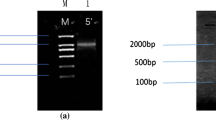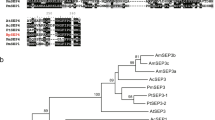Abstract
WAG-2 is a C-class MADS-box gene, which is orthologous to AGAMOUS (AG) in Arabidopsis. The AG group C-class MADS-box genes are involved in stamen and pistil identity. In this study, two WAG-2 transcripts, namely, WAG-2f and WAG-2g, were isolated and characterized from Aegilops tauschii. The open reading frames of WAG-2f and WAG-2g were 825 and 822 bp, respectively, encoding 275 and 274 amino acid residues. BLAST searches of partial WAG-2 genomic sequence against the draft sequence of Ae. tauschii genome database revealed the complex structure of WAG-2 gene, which consisted of seven exons and six introns. The WAG-2f and WAG-2g cDNAs were two alternative splicing transcripts. The alternative splicing events were produced by an alternative 5 ′ splice site. The expression level of WAG-2f transcript, which was extremely weak in young spikes of floret primordium formation stage, increased as the spikes developed. The highest expression was observed in the spikes at the anther separation stage. Low expression levels of WAG-2f were also detected at the tetrad stage. The WAG-2g transcript was expressed at all four stages of spike development but at a relatively low level. The expression pattern of the two transcripts was distinctly different during floral development, thereby suggesting a functional divergence.



Similar content being viewed by others
References
Ambrose B. A., Lerner D. R., Ciceri P., Padilla C. M., Yanofsky M. F. and Schmidt R. J. 2000 Molecular and genetic analyses of the Silky1 gene reveals conservation in floral organ specification between eudicots and monocots. Mol. Cell 5, 569–579.
Angenent G. C. and Colombo L. 1996 Molecular control of ovule development. Trends Plant Sci. 1, 228–232.
Cheng Y., Kato N., Wang W., Li J. and Chen X. 2003 Two RNA binding proteins, HEN4 and Hua1, act in the processing of AGAMOUS pre-mRNA in Arabidopsis thaliana. Dev. Cell 4, 53–66.
Davies B. and Schwarz-Sommer Z. 1994 Control of floral organ identity by homeotic MADS-box transcription factors. In Plant promoters and transcription factors (ed. L. Nover), pp. 235–258. Springer Berlin Heidelberg, New York, USA.
Feldman M. 2001 Origin of cultivated wheat. In The world wheat book: a history of wheat breeding (ed. A. P. Bonjean and W. J. Angus), pp. 3–56. Lavoisier, London.
Filichkin S. A., Priest H. D., Givan S. A., Shen R., Bryant D. W., Fox S. E. and Wong W. K. 2010 Genome-wide mapping of alternative splicing in Arabidopsis thaliana. Genome Res. 20, 45–58.
Hama E., Takumi S., Ogihara Y. and Murai K. 2004 Pistillody is caused by alterations to the class-B MADS-box gene expression pattern in alloplasmic wheats. Planta 218, 712–720.
Kang H. G., Jeon J. S., Lee S. and An G. 1998 Identification of class B and class C floral organ identity genes from rice plants. Plant Mol. Biol. 38, 1021–1029.
Kitahara K. and Matsumoto S. 2000 Rose MADS-box genes ‘MASAKOC1 and D1’ homologous to class C floral identity genes. Plant Sci. 151, 121–134.
Kyozuka J. and Shimamoto K. 2002 Ectopic expression of OsMADS3, a rice ortholog of AGAMOUS, caused a homeotic transformation of lodicules to stamens in transgenic rice plants. Plant Cell Physiol. 43, 130–135.
Kyozuka J., Kobayashi T., Morita M. and Shimamoto K. 2000 Spatially and temporally regulated expression of rice MADS box genes with similarity to Arabidopsis class A, B and C genes. Plant Cell Physiol. 41, 710–718.
Lightfoot D. J., Malone K. M., Timmis J. N. and Orford S. J. 2008 Evidence for alternative splicing of MADS-box transcripts in developing cotton fibre cells. Mol. Genet. Genomics 279, 75–85.
Macknight R. C., Duroux M., Laurie R. E., Dijkwel P., Simpson G. and Dean C. 2002 Functional significance of the altemative transcript processing of the Arabidopsis floral promoter FCA. Plant Cell 14, 877–888.
Mizumoto K., Hatano H., Hirabayashi C., Murai K. and Takumi 2009 Altered expression of wheat AINTEGUMENTA homolog, WANT-1, in pistil and pistil-like transformed stamen of an alloplasmic line with Aegilops crassa cytoplasm. Dev. Genes Evol. 219, 175–187.
Pan Q., Shai O., Lee L. J., Frey B. J. and Blencowe B. J. 2008 Deep surveying of alternative splicing complexity in the human transcriptome by high-throughput sequencing. Nat. Genet. 40, 1413–1415.
Parenicova L, de Folter S., Kieffer M., Horner D., Favalli C., Busscher J. et al. 2003 Molecular and phylogenetic analyses of the complete MADS-box transcription factor family in Arabidopsis: new openings to the MADS world. Plant Cell 15, 1538–1551.
Riechmann J. L. and Meyerowitz E. M. 1997 MADS domain proteins in plant development. Biol. Chem. 378, 1079–1101.
Theissen G. 2001 Development of floral organ identity: stories from the MADS house. Curr. Opin. Plant Biol. 4, 75–85.
Theissen G. and Saedler H. 1999 The golden decade of molecular floral development (1990–1999): a cheerful obituary. Dev. Genet. 25, 181–193.
Wang B. and Brendel V. 2006 Genome wide comparative analysis of alterative splicing in plants. Proc. Natl. Acad. Sci. USA 103, 7175–7180.
Wang E. T., Sandberg R., Luo S., Khrebtukova I., Zhang L., Mayr C. et al. 2008 Alternative isoform regulation in human tissue transcriptomes. Nature 456, 470–476.
Weigel D. and Meyerowitz E. M. 1994 The ABCs of floral homeotic genes. Cell 78, 203–209.
Acknowledgements
This work was financially supported by the National Natural Science Foundation of China (31501304) and the Doctor Startup Foundation Project of China, West Normal University (13E002).
Author information
Authors and Affiliations
Corresponding author
Additional information
[Wei S. 2016 Molecular cloning, characterization and expression of WAG-2 alternative splicing transcripts in developing spikes of Aegilops tauschii. J. Genet. 95, xx–xx]
Rights and permissions
About this article
Cite this article
WEI, S. Molecular cloning, characterization and expression of WAG-2 alternative splicing transcripts in developing spikes of Aegilops tauschii . J Genet 95, 581–585 (2016). https://doi.org/10.1007/s12041-016-0668-4
Received:
Revised:
Accepted:
Published:
Issue Date:
DOI: https://doi.org/10.1007/s12041-016-0668-4




